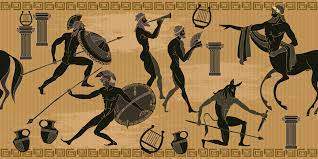The history of Ancient Greece includes the history of the territories of the modern nation-state of Greece, as well as the history of the Greek towns and the territories that they historically inhabited and governed. The scope of settlement and the Greeks’ dominion varied over the course of centuries, making the history of Greece equally flexible in its contents.
History of Ancient Greece
Table of Contents
From the point of view of education and Physical Education, the history of Ancient Greece can be mainly divided into four parts, which are as follows-
1. Homer Period
2. Sparta Period
3. Early Athenian Period
4. Later Athenian Period
Homer period in Ancient Greece-
During this period of Ancient Greece, the main occupation of the people was agriculture and animal husbandry. Through these people, he was used to complete their daily routine of life. In this period of Greece, there was a poet named Homer who was blind since birth, he composed two main epic poems, the Iliad and Odyssey, in his lifetime, which is compared with the Vedas written by Maharishi Vedvyas. The great Homer is considered the Guru of Greece. Homer described physical activities like archery, wrestling, chariot racing, javelin throwing, etc. in his poems. During this period, people believed that the gods decided their fate. The main religion of the people in this period was humanity and natural beauty. The aim of education in this period was Man of Action and Man of Wisdom. The life of the Greeks during the Homer period was based on religious principles.
Sparta period in Ancient Greece-
This period of Ancient Greece is also called the Classical Era. Cities and states emerged during this period. During this period, the program of physical education was difficult and the main objective of physical education was to prepare soldiers by giving special emphasis on military training.
Sparta was situated on the banks of the river Eurotas. The education system of Sparta was very orderly and systematic which was called Agoge. The operator of this systematic education system was called Paidonomus. Sports were given great importance during the Spartan period. In Spartan times, playgrounds were called Platanistas.
The following details are available regarding the life of children and youth during the Spartan period-
From birth till 7 years the child remained under the mother’s protection. After that, the child used to learn discipline in the barracks for 12 years. They were given rigorous military training for 12 to 20 years and their physical strength was greatly enhanced. For 20 to 30 years, they were trained to use various types of weapons. Youth were allowed to marry only after the age of 30. All the youth served the country for 60 years.
In Sparta, the dance involving gymnastics was known as the Bibabis dance. The religious dances performed during religious ceremonies were known as Haremus and Casaitis respectively. The dance performed by the soldiers was known as Papihik dance. In ancient Sparta, Yavana descendants or youth were called city soldiers.
During the Spartan period, state officials used to examine infants at the time of birth. Only if the child was completely healthy was he entitled to live. And if the child had any disability or weakness, then that child was thrown from a mountain called Tiegatus and died.
During the Spartan period, there were mainly two assemblies to assist the king.
Byul- Assembly of feudal lords.
Agora – Assembly of free citizens.
The main aim of physical education during the Spartan period was to prepare a good soldier. The people of this period hated the people of Homer’s period. But even in this period, the aim of education was a man of action. The sport of wrestling was more popular among the people during the Spartan period. During the Spartan period, women also received education like men. And women could also perform physical activities openly for 20 years. The practice of hero worship was strongly prevalent during this period.
Early Athens period in Ancient Greece-
in Ancient Greece, Athens was earlier known as Akte and Aktike. This name is derived from the name of the first king Acteos. The people of this period were democrats. Even during this period, the child remained under the protection of his mother till the age of 7 years, after 7 years the child received education in first-grade school. Along with military education, special emphasis was also given to moral education.
During this period, special emphasis was given to dance, hence a special type of gymnastic exercise was done to prepare for dance, which was called Gesticulation. Special emphasis was given to physical activities to increase physical abilities. The gymnasium where all these activities were performed was called Palestra, in which training in wrestling, boxing, and gymnastics was given. The physical teacher who performed physical activities in the Palaestra was called Paedotribe. During this period, under many national sports festivals, four festivals were organized which were as follows – Olympic Sports Festival, Pythian Sports Festival, Isthmian Sports Festival, and Nemean Sports Festival.
Later Athens Period in Ancient Greece-
This period of Ancient Greece was called the golden age of physical education. During this period, individualism was prevalent everywhere and more emphasis was given to the personality development of the individual. This period is also called the period of philosophers because in this period there were revolutionary philosophers Socrates, Plato, and Aristotle. More emphasis was given to medicinal exercises. Through which the physical health of a person was analyzed through exercise.
Hippocrates was called the promoter of medical exercise because he laid more emphasis on medical exercise and he used to treat his patients only through medical exercise. In today’s era, he is called the father of medical science.

